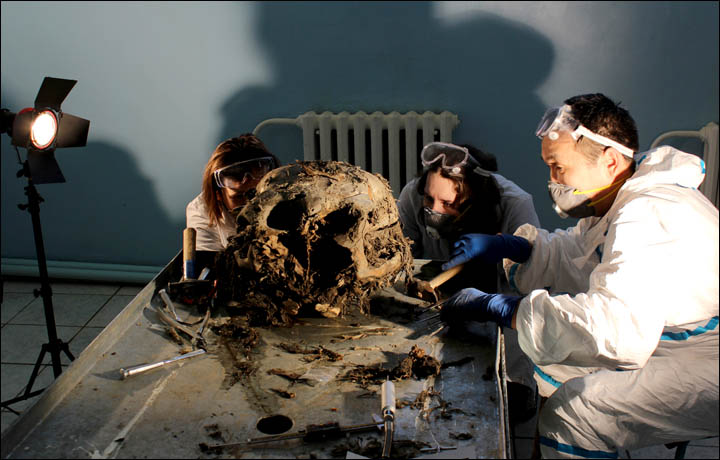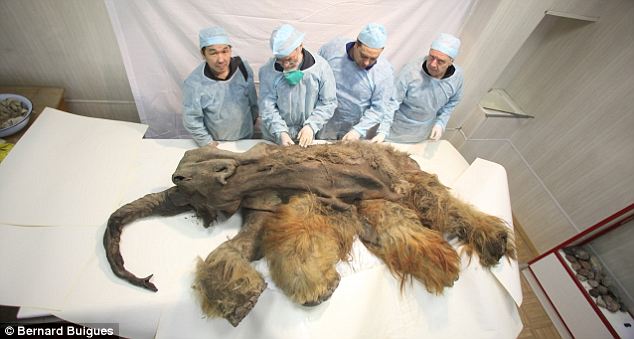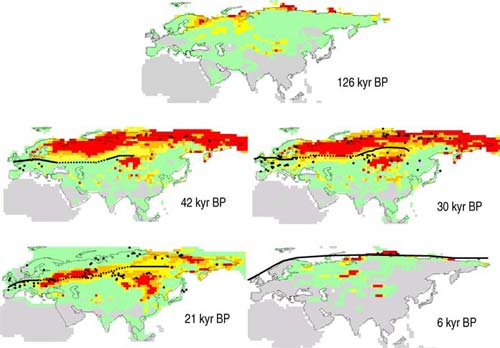My most recent pang of jealousy occurred on finding out that Yuka, one of the more famed frozen mammoth corpses is to have her brain scanned. What I would give to be able to have an intact brain in any of my fossils! The closest we have to a preserved brain in my period is an allegedly preserved nervous system in an arthropod (which, I'm sorry to say, I'm very, very dubious of, but I won't go into that now).

The mammoth has become part of the popular consciousness as a symbol of the ice age. It is the main representative of the great beasts of old, and epitomises a world that has been lost.
But, perhaps it is because it has been so mythologised, the mammoth is also likely to be the most misunderstood - or perhaps, misrepresented - extinct animals. Partly this is down to ubiquity; the more an idea is spread, the more likely it is to have misunderstandings spread.
In fact, there are some facts about the mammoth that are almost jarring to hear. The first of these - whisper it - is that mammoths aren't really ice loving animals. Mammoths certainly were pushed further north closer to their eventual extinction, but for the most part, mammoth lived in lush grasslands called mammoth steppe, more akin to a savannah. These beasts probably needed to eat a quarter of a tonne of plant matter every day, like elephants, which is something that snowy climates couldn't provide.

Not like this...

...and more like this
It's easy to see how this idea perpetuates: so many mammoths are found in permafrost that its simple to assume that they only lived there. We also tend to conflate "mammoth" with "woolly mammoth"; a woolly mammoth is just one type of mammoth, the other main type being a columbian mammoth, which lived right down to Mexico. This also means, to clear up another misconception, mammoths didn't snow plough with their tusks; there'd be little use for that in Mexico, even in the ice age. It is certainly true that mammoths were better adapted to colder conditions than their cousins, the elephants - we know from their genes that their haemoglobin is better suited to colder climates - but then, this is not surprising, given that mammoths ranged over much of eurasia, whereas elephants ranged over warmer africa, india and china.
Mammoths, in fact, really are elephants. Indeed, the Indian elelphant is much more closely related to mammoths than it is to an african elephant. Furthermore, mammoths weren't really "mammoth", or at least, not compared to an elephant. The adult males are more or less the same size as adult elephants.

Baby mammoths are the most commonly found in permafrost
Another misconception about mammoths that we get from these permafrost fossils is that their hair was orange. It wasn't. It was black. The reason for this is that the pigment responsible for the black colouration is broken down, whereas the orange pigment isn't, leaving the hair that distinctive orange colour. This has now been confirmed from looking at the genes.
The genes. Now, here is a subject that will disappoint many people. Feel free to disagree with me here, but mammoths will almost certainly never be cloned. Yes, we find very well preserved bits of DNA in frozen mammoths, and yes, we can pick out individual genes, but that's as far as it will ever go. The reason I'm citing is pure chemistry; even under the most ideal conditions DNA has a half life of around 500 years. This means that after 500 years, half the bonds are broken, after 1000, three quarters, and so on. Mammoths went extinct around 4000 years ago, meaning that mammoths found preserved have a soup of largely useless DNA.
There's another rather striking fact, or at least it was for me. The mammoth was still around when the Great Pyramid of Giza was being built. I'm not sure which part of that fact is more striking; that the mammoths were so recent or that the pyramids were so old.
All of which begs the question, why aren't mammoths around today? After all, they got so tantalizingly close. Perhaps it is a sign of the times, but in general, we tend to hold up our hands and blame our naughty ancestors for killing all of the mammoths. There is much debate on this, but I think the consensus seems to lie on the main thing that killed mammoths being trees, or rather, the spread of trees. I mentioned above that mammoths were adapted to the mammoth steppe environment; a rich grassland that covered much of eurasia. Through no fault of our own, this environment was steadily replaced by woodland, which the mammoths could not subside off of. This is the main reason why the mammoth was driven north, to islands off of the north coast of Russia.

Black line is the spread of humans. Red is the suitable habitat for mammoths.
We are not entirely blameless, however. Yes, mammoths were reduced in number, however, the islands that they were confined to still contained - and still contain to this day - mammoth steppe grassland, to which they were perfectly suited. It is likely, however, that we dealt the last blow, in killing this last refugia of mammoths.
As I said above, debate exists on what had the greater role, but one thing that is pretty clear is that the impact of man has been overstated. It's not hard to see why; there is clear evidence that man hunted mammoths, as mammoths have been found with spears and axes embedded in them. Furthermore, many objects made of mammoth ivory have been found, including boomerangs, statues - even entire tusk villages. But it is likely that these bones were scavenged rather than hunted for.
One final thing that is misunderstood is the mammoth ivory trade. I've written before on how having free and open trade of fossils is better, because it prevents the creation of a black market. However, at the moment, mammoth ivory is being sold as a replacement to elephant ivory. It might be possible to argue that at least this prevents elephants being poached; after all, the mammoths were dead anyway, and we have lots of mammoth fossils. However, this selling enables and legitimises the ivory trade. As a result, I think that mammoth ivory should become the first fossil to be globally protected, not just to protect modern elephants, but to protect their heritage in their ancient, extinct cousins.
---
Best book for this is Adrian Lister's, and many of the facts for this were taken from a talk he gave here in Leicester a couple of weeks ago. Link is here http://www.amazon.com/Mammoths-Giants-Ice-Adrian-Lister/dp/0520261607





Comments